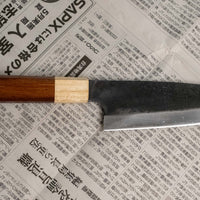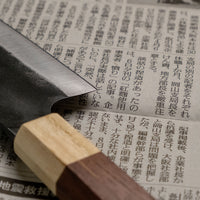




Yoshida Santoku Funayuki SUJ-2 Kuro-uchi 155mm (6.1") [Rosewood-Cedar/Octagon]
🚩 This blade will develop patina with use, while improper maintenance may lead to rust formation.
|
✔︎ No import fees & duties - worldwide |
- Description
- Specifications
- Knife Care
- Shipping
This Yoshida Santoku Funayuki SUJ-2 Kuro-uchi 155mm (6.1") blade is fitted with an octagonal rosewood handle, topped with a cedar wood ferrule. It is also available without a handle (in case you would like to fit it with a custom handle of your choice).
The price of this knife is very affordable for the quality of a hand-forged knife. The blade is forged from SUJ-2 steel, which offers incredible capacities, hardness is 63-64 HRC, and at the same time, the knife is very easy to resharpen. The blade requires some extra maintenance. After use, rinse it well and dry it. The name kuro-uchi refers to the blade finish, which is unprocessed on top and has already developed a dark patina, which protects the blade from rust.
BLADE PROFILE:
Yoshida Santoku Funayuki SUJ-2 Kuro-uchi is a versatile kitchen knife that will excel at all kinds of chopping and cutting on the cutting board, only missing an inch of length when it comes to large cuts of meat. The Funayuki differs from the basic Santoku knife in the shape of the blade: the slope of the blade slowly rises towards the tip of the knife, creating a slight curve in the belly of the blade. This loses the standard Santoku blade shape, which resembles a sheep's foot, and creates a thinner blade that resembles a deba in shape, but is extremely thin and precise (and not suitable for chopping bones and robust tasks). The curve makes the knife more suitable for certain chopping techniques, such as rocking. The pronounced tip and triangular design will be great for cutting smaller pieces of meat and filleting fish.
The word Funayuki means "going on boat" and was designed for use on board fishing boats to allow fishermen to quickly cut and clean fish and check the quality of the catch.
STEEL:
The blade is forged in SUJ-2 steel, which offers incredible capacities, hardness is 63-64 HRC, and at the same time, the knife is very easy to resharpen. The blade requires some extra maintenance. After use, rinse it well and dry it.
LAMINATION:
The blade’s core was laminated using the san-mai method to improve its structural integrity and subsequent ability to withstand impacts and prevent chipping. San-mai translates to “three layers” in Japanese, referring to a blade that is composed of a primary, inner layer of harder steel (hagane) and of two secondary, outer layers of softer steel (jigane) that protect the prior.
→ Read more on Blade Construction: Lamination.
GEOMETRY:
It has a double bevel (symmetrical) blade (50/50) with a convex v-edge grind.
BLADE FINISH:
The blade sports a raw kurouchi finish which gives it a rustic appearance. The stamp on the blade 吉 (Kichi) means luck.
HANDLE:
The blade is fitted with a traditional Japanese wa hande in an octagonal shape. It is made from rosewood and topped with a ferrule made from cedar wood.
SMITHY:
Yoshida Hamono is a family-owned Japanese company with an age-long tradition in manufacturing state-of-the-art tools and Japanese swords (katanas) by hand. The company has a workshop in the Japanese town of Saga. It is well-known for manufacturing metal products in tested corrosion-resistant materials, such as VG-10, Ginsan and Swedish steel. You can learn more about them and our visit to their workshop here.
Blade shape: Santoku Funayuki
Steel type: SUJ-2
Blade construction: San-mai / convex v-edge / kuro-uchi
Hardness (HRC scale): 63-64
Overall length: 300mm (11.8")
Blade length: 155mm (6.1")
Blade height: 47mm (1.8")
Spine thickness: 2.0mm (0.09")
Weight: 120g (4.2 oz)
Handle length: 136mm (5.3")
Handle type / wood: Japanese wa handle/ rosewood
Kanji on the blade:
Blacksmith: Yoshida Hamono
Location of the smithy: SAGA / Saga Prefektura / Japan
☝️ Japanese kitchen knives in our store are handmade from natural materials. Slight variations in color, texture, weight and other dimensions are possible. We try to give a good photographic representation of our products, however computer screen resolution and colors do vary, so products might not look exactly as they are seen on screen.

☝️ THIS KNIFE MAY DEVELOP PATINA
Knives made of carbon steels can, due to their low chromium (Cr) content, discolor and develop patina. The knife is the most sensitive when it is still new and a patina had not developed yet, but later, patina will protect the blade. These types of knives require a touch more care:
✔ Wipe it regularly with a clean and dry cloth (you can also do this during use).
✔ After use, rinse it with lukewarm water and wipe it dry.
✔ Coat it regularly with knife maintenance oil or plain refined sunflower oil.
✔ Store the knife by wrapping it in paper which will absorb moisture and protect the blade.
A patina is a thin layer that forms on the surface of oxidized steel and protects it from further oxidation. The patina should not be confused with rust. Patina protects the blade, while rust causes corrosion and deterioration of material, so it should be removed (see Rust erasers).
→ For in-depth information about patina, read our dedicated post on patina.
GENERAL KNIFE CARE TIPS:
Blade wear depends on the quality of steel, usage and maintenance of the blade. Japanese knives are made of high-quality steels. Follow these tips to keep your Japanese knife in top-notch shape:
✔ Use a wooden, plastic or rubber cutting board.
✔ After use, wash the knives and wipe them dry.
✔ For storage, use a knife holder or a protective knife sheath (saya).
✔ A good cutting technique is your best bet to prolong sharpness.
✔ Use sharpening stones to sharpen the knife.
❗️Don’t leave the knife in the sink. Wash it by hand.
❗️Don’t wash the knife in the dishwasher.
❗️Don’t use the knife on glass, ceramics, marble or steel surfaces.
❗️Don’t scrape the food off the cutting board with the edge of the blade. Use the spine of the knife instead.
❗️Knife is a tool intended for specific use - cutting food. It is not a can opener, screwdriver, trowel, wire cutter, hammer etc.
→ For more details, read our guide
on Maintenance of Kitchen Knives.
🤙 Contact us if you need some help. We reply within 1 business day.
SHIPPING RATES:
- €10 - flat worldwide rate with DHL Express (express delivery, 2-5 business days).
- FREE - all orders over €300 (DHL Express).
EXCEPTIONS:
See our Shipping page for more details.
DUTIES AND IMPORT TAXES:
We ship all orders DDP (duties & taxes paid). This means you will not be charged for any import fees and taxes (including VAT). All our prices are final. The price you see at checkout is the final price, no hidden costs.
DELIVERY TIME:
- Europe: 1-2 business days
- US & Canada: 2-4 business days
- Rest of the World: 3-5 business days
RETURNS:
Our return policy lasts 30 days. If more than 30 days have gone by since the day you received your order, unfortunately we can’t offer you a refund or exchange.
→ Read our SHIPPING & RETURNS policy for more info. We strive to solve any issues fast and with as little hassle for you. If you have some additional questions, please contact us.
Each knife comes with:
✔️ Instructions and knife care leaflet.
✔️ A preventive Band-Aid – the knives are very sharp! 😉
✔️ Original box from the blacksmith, which we wrap in an old Japanese newspaper sheet – so every knife is ready to be passed on as a gift as soon as it hits your doorstep!
✔️ We also offer a special gift wrapping option with the traditional Japanese washi paper.
Quiz
Still doubting which type of Japanese knife should best fit your needs?
We created a 5-steps quiz to help you find the perfect knife based on your cooking skills and the type of food you prepare.





